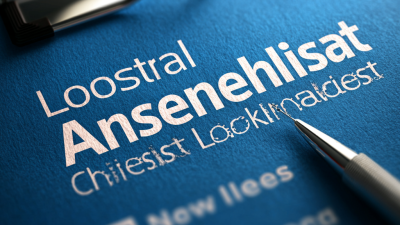In contemporary dentistry, the application of Local Anesthesia has revolutionized patient care and procedural outcomes, allowing practitioners to perform complex treatments with minimal discomfort. According to a report by the American Dental Association, approximately 80% of dental procedures today utilize some form of Local Anesthesia, highlighting its crucial role in enhancing the patient experience. Moreover, advancements in anesthetic agents and techniques have significantly increased the efficiency of dental workflows, with many procedures being completed in a fraction of the time compared to previous decades. Studies indicate that patients who receive Local Anesthesia report higher satisfaction levels and lower anxiety, ultimately leading to improved treatment adherence and better overall oral health. As dental technologies continue to evolve, the significance of Local Anesthesia in ensuring pain-free, effective dental care becomes more prominent, making it an indispensable component of modern dental practice.

 Local anesthesia plays a crucial role in modern dental procedures, significantly minimizing pain and discomfort for patients. By temporarily blocking nerve sensations in the targeted area, local anesthesia allows dentists to perform a wide range of treatments—from routine cleanings to complex surgeries—without causing undue distress. This approach not only enhances the overall patient experience but also instills greater confidence in individuals who may be anxious about dental visits.
Local anesthesia plays a crucial role in modern dental procedures, significantly minimizing pain and discomfort for patients. By temporarily blocking nerve sensations in the targeted area, local anesthesia allows dentists to perform a wide range of treatments—from routine cleanings to complex surgeries—without causing undue distress. This approach not only enhances the overall patient experience but also instills greater confidence in individuals who may be anxious about dental visits.
Here are some tips for patients to prepare for using local anesthesia during dental procedures:
The effectiveness of local anesthesia not only reduces pain but also allows for quicker recovery times. By focusing on minimizing discomfort, dental professionals can provide treatment that is both efficient and compassionate, ultimately leading to healthier smiles and happier patients.
Local anesthesia plays a crucial role in enhancing patient comfort and cooperation during dental procedures. According to a study published in the Journal of the American Dental Association, proper administration of local anesthesia can increase patient satisfaction rates by over 75%. This significant improvement is largely attributed to the reduced pain perception during procedures, which allows patients to remain calm and cooperative. Enhanced comfort translates to a more successful and efficient dental experience, benefiting both the patient and the clinician.
Furthermore, the American Dental Association reports that about 90% of patients who received local anesthesia felt little to no pain during their treatment, leading to decreased anxiety levels. This high level of comfort encourages patients to attend regular dental visits, which is essential for maintaining oral health. Additionally, with advancements in dental anesthesia techniques, such as the use of computer-controlled delivery systems, clinicians can provide even more precise and effective pain management. This not only improves the quality of care but also fosters a trusting relationship between patients and their dental providers, ultimately promoting better oral health outcomes.
This chart illustrates the impact of local anesthesia on patient comfort and cooperation during dental procedures. The data reflects patient feedback on various aspects of their experience with and without the use of local anesthesia.
Local anesthesia plays a crucial role in modern dental practices, ensuring patient comfort and minimizing pain during various procedures. Dentists commonly utilize several types of local anesthetics to achieve these goals, each with its own distinct characteristics. The most widely used local anesthetic is lidocaine, known for its rapid onset and moderate duration of action. It effectively numbs the targeted area, making it suitable for routine procedures like fillings and extractions.

In addition to lidocaine, dentists may use articaine, which has gained popularity due to its superior penetration properties. Articaine is particularly beneficial for specific dental techniques, such as nerve blocks, as it provides deeper anesthesia and faster recovery times. Another option is mepivacaine, which offers a shorter duration of action, making it ideal for minor procedures or patients with specific medical conditions. Understanding these various types of local anesthesia allows dental professionals to tailor their approach, ensuring a safe and comfortable experience for every patient.
Local anesthesia plays a crucial role in modern dental procedures, significantly impacting recovery times and the overall efficacy of treatment. By temporarily numbing specific areas of the mouth, local anesthetics allow patients to undergo procedures like fillings, extractions, and root canals without experiencing pain. This targeted approach not only enhances patient comfort but also enables dentists to perform more complex treatments in a single appointment, thereby reducing the need for multiple visits.
The effect of local anesthesia on recovery times is particularly noteworthy. Patients often experience less postoperative discomfort, allowing them to resume normal activities more quickly. This can lead to a more positive perception of dental care, as individuals are less likely to associate it with prolonged pain or downtime. Additionally, the effectiveness of local anesthesia can contribute to improved treatment outcomes, as patients are more likely to tolerate longer procedures without anxiety, leading to better overall results. The integration of local anesthesia into dental practices represents a significant advancement in patient care, making dental visits more manageable and efficient.
| Procedure | Anesthesia Type | Average Recovery Time (Hours) | Treatment Efficacy (%) |
|---|---|---|---|
| Tooth Extraction | Local Anesthetic | 4 | 90 |
| Cavity Filling | Local Anesthetic | 2 | 85 |
| Root Canal Treatment | Local Anesthetic | 6 | 92 |
| Gum Surgery | Local Anesthetic | 8 | 88 |
| Dental Implants | Local Anesthetic | 12 | 95 |
Local anesthesia plays a crucial role in modern dental procedures, yet many patients harbor misconceptions about its use and effects. One common concern is the fear of pain during the administration of the anesthetic itself. However, dental professionals are trained to minimize discomfort through techniques such as using topical anesthetics before the injection. This preparation significantly alleviates the sensation of the needle, making the process much more comfortable for the patient.
Additionally, some individuals worry about the potential side effects of local anesthesia, fearing lingering numbness or allergic reactions. In reality, the effects of local anesthetics are temporary and usually wear off within a few hours, allowing patients to return to normal activities swiftly. Allergic reactions are exceedingly rare, especially with the widely used anesthetic agents. Understanding these factors can help dispel anxieties associated with local anesthesia, allowing patients to approach dental visits with greater confidence and peace of mind.






